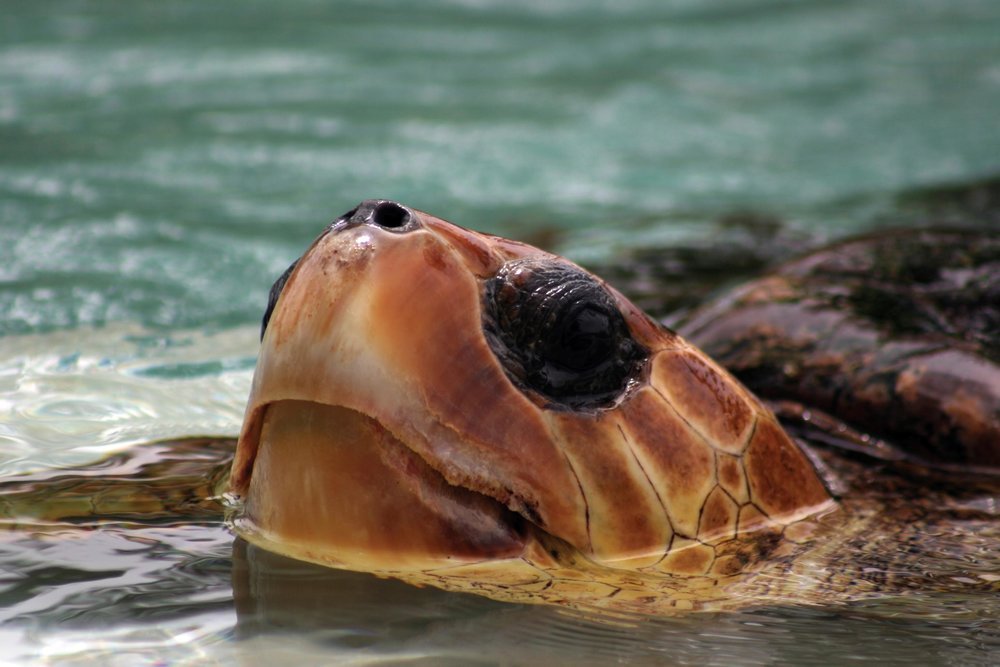The Mystery of Turtle Senses: How do sea turtles sense their environment?
By Catherine M. F. Lohmann
A loggerhead surfaces to breathe. © JAMI GARRISON
Sensory information plays a vital role in helping animals find food, locate mates, evade predators, and navigate from place to place. The way an animal senses its environment can determine its survival strategies. A bat, for instance, uses echolocation to locate prey and thus can hunt at night; a human being uses vision and is thus restricted to daylight. So how do sea turtles sense the world? How do their abilities influence their survival? Such questions are critical in assessing the habitat needs of sea turtles and other endangered species and in identifying risks that might otherwise be overlooked.
Sea turtles, like humans, have a well-developed visual sense. They can perceive color and have visual acuity sufficient for detecting small benthic prey and for recognizing and evading sharks. They may also have visual adaptations that suit them for their marine environment. The distribution of rods in the eye suggests good low-light vision for foraging at depth and for finding the sea as hatchlings. Evidence suggests that turtles might perceive some visual cues that humans cannot, including ultraviolet light and possibly polarized light. If so, these abilities may help turtles to perceive prey such as jellyfish that would otherwise be transparent.
Sea turtles are capable of hearing, but they appear sensitive only to low-frequency sounds commonly found in near-shore waters (such as the sounds of ocean waves breaking on beaches). It has been suggested, though not proven, that adult turtles use these sounds to help them locate nesting beaches once they have drawn into the vicinity. The possibility that turtles can detect infrasound (sound too low for humans to hear) has also not yet been investigated.
Like all other aquatic animals, sea turtles can sense chemicals in sea water. Amino acids and other biochemicals emanate from all organisms and enable turtles to locate underwater food sources. In principle, turtles might also use chemoreception to identify the chemical signatures of particular geographic areas, but again, this is unknown. Similarly, it is possible that sea turtles detect airborne chemicals when surfacing to breathe, although such ability has not yet been demonstrated.
Sea turtles are exceedingly sensitive to water movements associated with ocean waves. Hatchlings entering the sea for the first time use this ability to guide themselves offshore by orienting their swimming relative to wave direction. We do not know if adults retain this sensitivity. The ability might be useful in maintaining consistent courses, in detecting wave patterns associated with islands (from distances at which the islands cannot be seen), or in detecting changes in underwater landscape in relatively shallow water.
Sea turtles have at least one major sensory ability that humans lack: the ability to perceive Earth’s magnetic field. The magnetic sense of sea turtles appears to be remarkably sophisticated, allowing them to obtain both directional and positional information. Turtles can perceive the direction of the magnetic field much as a compass does and can thus distinguish between north and south, as one example. In addition, they can detect subtle variations in Earth’s magnetic field, and they use this ability in long-distance navigation. The magnetic field is a particularly useful source of navigational information in the ocean, because it is present at all depths, remains constant during day and night, and does not vary with weather or season.
Many questions remain. What sensory abilities are used in locating mates or in communication? Do sea turtles possess any other major sensory abilities that have been overlooked? At this time, there is no evidence that they have the anatomical structures needed for echolocation, electroreception, or infrared detection. But there is, of course, no way to be sure that they do not have other sensory abilities or use common abilities in novel ways. Only time and careful research will tell.
This article originally appeared in SWOT Report, vol. 2 (2007). Click here to download the entire article as a PDF.

